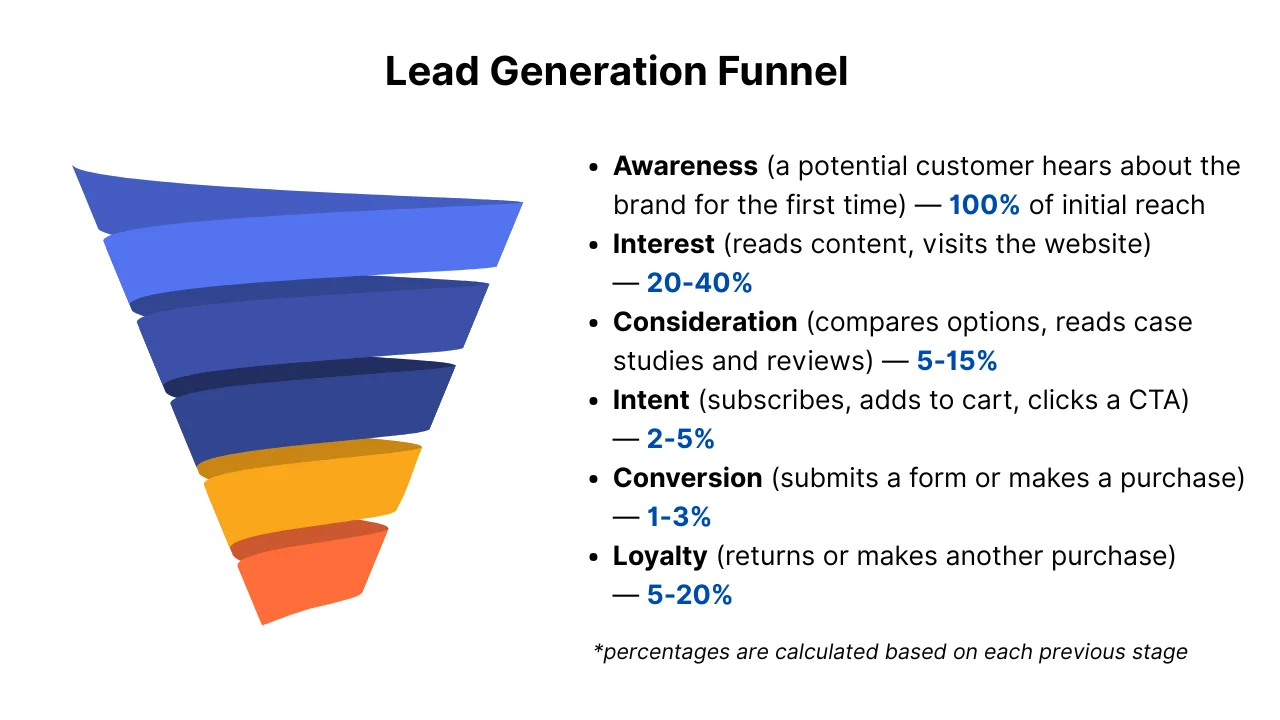
- What Is a Lead and Why It Matters for Business
- What Is Lead Generation
- Main Lead Generation Channels
- How to Evaluate Lead Quality
- Lead Generation Tools
In modern business, growth is impossible without a steady flow of inquiries. Companies invest resources in advertising, social media, and websites, but the main question remains the same — how to attract real clients. That’s exactly what lead generation is for — a systematic process of obtaining new contacts who can become buyers. It’s a process that combines marketing, sales, and analytics, providing businesses with stability and predictable revenue.
What Is a Lead and Why It Matters for Business
A lead is a potential customer who has shown interest in your product or service. They might fill out a form on your website, click the “Request a Call” button, subscribe to a newsletter, or simply send a message in chat.
A lead is essentially a bridge between interest and purchase. That’s why businesses must not only attract traffic to their website but also convert it into inquiries. Companies that know how to work with leads build a predictable sales funnel — from the first site visit to the final purchase. Every lead is an opportunity to turn curiosity into revenue.
There are three main types of leads, depending on their readiness to buy: cold, warm, and hot.

For a business, it’s important not only to collect contacts but also to understand their quality and stage in the funnel. A surplus of “raw” inquiries without follow-up doesn’t generate profit, while even a small number of qualified, well-handled leads can ensure steady sales.
Effective lead management isn’t just about gathering forms — it’s about systematically building trust. Marketing attracts attention, the CRM system organizes data, and sales turn interest into results. This triangle forms the foundation of sustainable business growth.
Read also: CRM systems — what they are, why they are needed and which one to choose
What Is Lead Generation
Lead generation is the process of acquiring potential customers through various channels — websites, ads, social media, partnerships, or email marketing. Its main goal is to attract an interested audience and deliver qualified leads to the sales team.
Lead generation covers the entire user journey — from the first click to filling out a form. That’s why it’s crucial to plan every stage of communication: the ad message, landing page, contact form, and response speed of the sales team. Without this, even the best advertising campaign won’t bring results.

Main Lead Generation Channels
To ensure a steady flow of leads, a business should use several channels simultaneously. Each has its own advantages, cost, and specifics.
- Website and SEO promotion. An optimized website attracts traffic from search engines. People come on their own, looking for a product they need. A contact form or online chat converts visitors into potential clients. It’s essential that the page loads quickly, has a clear structure, and inspires trust. The site’s speed and stability depend not only on code or image optimization but also on the technical infrastructure it runs on. That’s why you should ensure a reliable foundation and choose affordable web hosting that provides stable performance without unnecessary expenses.
Before launching a lead generation campaign, it’s worth analyzing the domain — making sure it hasn’t been penalized by search engines, has no negative history, and is correctly configured for SEO. This helps avoid technical issues and increases the chances of faster traffic growth.
- Advertising in Google Ads and Meta. This is a quick way to get targeted leads when people are already searching for your product. Paid search ads work on demand — you show up for users ready to buy.
- Email marketing. Newsletters help maintain communication with your client base, remind them about promotions, share updates, or offer new products. This channel is highly effective for repeat sales.
- Affiliate programs. Leads come from other companies or affiliate sites that receive a commission for referrals. This works well for B2B, insurance, finance, and education services.
- Social media. These platforms are not just for content — they’re powerful sales tools. On Facebook, Instagram, or LinkedIn, you can run targeted ads to your audience and get direct inquiries. Social media also builds brand awareness — users are more likely to contact companies they “know”.
The key to success is combining channels. SEO delivers long-term results, ads bring quick traffic, and social media builds trust. Together, they create a sustainable lead generation system that works continuously — even if one channel temporarily underperforms.
Read also: How to promote an online store: a strategy for increasing traffic and sales
How to Evaluate Lead Quality
The number of inquiries alone doesn’t define success. If many of them are random or irrelevant, the business wastes resources. That’s why it’s crucial to assess lead quality using several key metrics:
- MQL (Marketing Qualified Lead) — a contact that matches the target audience and has shown interest through marketing actions (e.g., requesting information, subscribing, attending a webinar).
- SQL (Sales Qualified Lead) — a lead verified by a sales manager as ready to buy.
- CPL (Cost Per Lead) — the average cost of acquiring one lead.
- Conversion rate — the ratio of purchases to total leads.
The higher the percentage of leads that turn into sales, the more effective your lead generation strategy is.
Lead Generation Tools
For lead generation to work consistently, it needs to be automated. Here are the main tools:
- CRM systems (HubSpot, Pipedrive) — store all contacts, communication history, and remind managers of tasks. Without a CRM, even the best advertising campaigns fail to deliver full visibility — data gets lost, inquiries go untracked, and follow-ups become difficult.
- Analytics tools (Google Analytics, Roistat, Power BI) — show where each lead came from, how much each inquiry costs, and which channels perform best. Analytics help identify weak spots, on-site drop-offs, or ineffective ads.
- Automation systems — email campaigns, chatbots, and communication workflows that save time and speed up response rates. Modern tools can automatically send emails, SMS, or messenger notifications right after a user’s action.
That’s why lead generation is not just marketing — it’s teamwork. Success depends on how well departments coordinate. Automation, CRM systems, and analytics create a transparent ecosystem where every inquiry can be tracked — from its source to the result.
Lead generation is more than advertising. It builds a system where every step — from the first contact to the purchase — is under control. Businesses that master this process gain not only sales but also predictability, stability, and a deep understanding of their audience.
The true value of lead generation lies in consistency. When every contact is tracked, analytics run automatically, and ads bring in qualified inquiries, marketing stops being a gamble. It becomes a strategy that turns chaos into a system and ensures a steady flow of clients.










